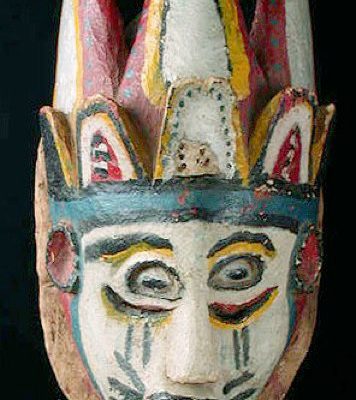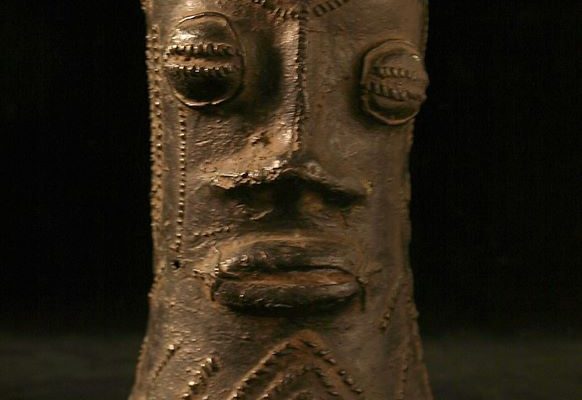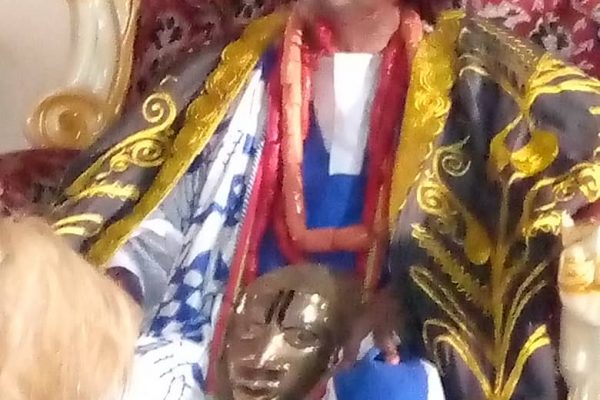Ócho Festival celebration dates back to the Middle Ages when Àtá Ìdoko Agánápojè – father of Àtá Áyẹ́gbà, founder of the ruling Third Igala Dynasty in Central Nigeria – was out hunting one day and lost his way in the bush. His followers searched everywhere but could not find him “till nearly nightfall.” The following day, he sent a message to his wives and retainers, saying:
“It is not right that nothing should be done to mark the occasion, or that no thanks given to Ọjọ (God), when a person of importance like me is lost and found again.”
According to Miles Clifford’s A Nigerian Chiefdom, the king ordered that a goat be brought; and he shot it with his bow and arrow, saying that it would not be fitting that he had not shot anything after so long a day’s hunt. He then charged his descendants to go through this ceremony every year, “when the grass is burnt and the hunting season begins.”
The goat was gutted and placed in a long, rectangular basket, which was covered with a white cloth and supported on forked sticks fixed upright in the ground. The intention for that was “to make a sort of mocking imitation of the burial of an Ata: that all men might see and know that a goat had died and not the Ata.”
His Royal Highness, the Ádọyí (Chief Hunter – Ágbojí-ọdẹ-Anẹ̀-Igáláà), argued that it was not a goat but a live wild animal, a Maxwell’s duicker (Átu), that Àtá Ìdoko Agánápojè ordered to be brought, noting that “goats are not found in forests.” He pointed out that his own office, as the Chief Hunter of the Kingdom, was vested with the constitutional responsibility to call forth a live duicker from the bush every year that the Ócho Festival was celebrated in the former times.
Festival Time-Table
Preparations for the festival start with the Àtá (Priest-King) asking his Chief Diviner, the Òhíúgáà, to consult the Ífá Oracle to determine “the most propitious location” for the year’s ceremony.” The Ífá‘s And its decision is kept secret till the festival date falls due.
On the D-Day, in the dark, pre-dawn weather, the rarely-seen royal masquerade, Ọ̀bàje-àdàká, comes out, its ritual staff emitting smoke, billowing to the sky. Then, the Priest-King, travelling incognito, appears, followed by the Áchányīwọ, an Ígálámẹ̄la chieftain. The king’s retainers (Àmedìbò) bearing some sacrificial livestock, carry the rear, as they head for the locations of three prominent deities: Ákwọ́, Òkwúta-Ádẹ̀kọ̀ and Ódé-ojí-Átā, on the outskirts of the capital in the vicinity of the Ínáchaló River.
The group returns in the evening to the Àtá’s Palace ‘Òlógbó-Àtá.’ The Áchányíwọ and Àtẹ́kpa-iwọ (Bearer of ‘íwọ’ poison antidote), and other key clansmen Ígálámẹ̄la clansmen perform rites mock-removing possible ‘íwọ’ poison that might have been laid on the Priest-King by his enemies. At day-break, they retire to their respective homes, to continue the rituals in their respective homesteads for the remaining eight days to the festival.
On the eve of the festival, Igalas from far and near converge on Ídá, their cradle and capital in celebratory mood. Meanwhile, behind the scene, at dawn of the D-Day, the Royal Diviner, carries his divining apparatus, sets out to physically take charge of the grounds chosen by the oracle. Later, he sends a message back to the Àtá, validating the spot. Then, at sun-up, the Àtá, accompanied by two of his important acolytes, by Ọ̀gbẹ̀ and Ẹ̀làkwu, moves over moves over to the place in utmost secrecy. The retainers erect a four-sided, ceremonial tent or Cloak-room (Únyí-ábò), the type king was dressed up in on his coronation day. Here, the Áchányíwọ, reverently holding the Ódeojí-Átā (Ata’s Guardian nature-god) with two hands, uses it to touch the king’s forehead, saying:
“Ẹ gbó kókóló; ẹ gbó tíjẹ̀-tìjẹ̀. Éjú k’ì lí ẹ́ ọdọ́-ī, k’í lí ẹ́ ọdọ́mọ́dọ́, álu k’ẹ̀ f’àbégwú réwá-ì.”
(Be very strong in your ripe old age. The eyes that see you this year shall see you again, year-in-year-out, as you have remembered the ancestors this day.”)
At noon, the king sends a message to his wives and retainers, informing them that he is out hunting and is without food or drink. In due course, a party bearing his meal arrives in the company of prominent, titled women, including the ‘Íye-ọ̀mọ̀nyí,’ the Ata’s Head-wife, and three others, ‘Íyé-Átā,’ ‘Àkwúma-Àtá’ and ‘Íye-Àdébú.’ The Head-wife “carries a slung satchel containing provisions and they express polite surprise at finding him in this pitiable predicament. The Ata, then, withdraws to his tent and is served with food and drink.” Later, his followers are provided refreshments.
Target-Shooting
Then comes the climax of the event, when the most prominent royal acolyte, Ọ̀gbẹ̀ “fetches the Ata from the tent, blindfolds him with a strip of cloth and, placing a small bow and arrow (similar to those used by boys) in his hands, leads him to within a few paces of the tethered animal outside. He now bids the Ata to shoot, and if, as generally happens, the arrow finds its target, there are great rejoicings and blowing of trumpets and drumming; for this is considered to be a good augury for the hunting season.” However, it is believed that an Ata’s failure to hit the target portends ill-omen.
To round off the event, the mammoth crowd at the Ocho grounds begins to move solemnly homewards in a procession, headed by the Ata’s wives. They are basking in the euphoria of their husband hitting the bulls-eye, extolling his hunting prowess in songs. The procession halts at the ‘Ẹ́rẹ-anẹ̀,’ the Earth Shrine, where the Áchádú and the Royal Councillors “are assembled to greet the Àtá,t” and at Ọ̀pù-àtá, his home-place at Idádá, where “he is welcomed and congratulated” by the aboriginal Ígálámẹ̄la clans who escort him to his palace. Finally, the king formally flags off the hunting season, wishing the hunters great luck and reminding them to bring to him the portions that are due to him: if an elephant, the tusks; and if a leopard, its skin. The rest of the festive evening is given to merry-making.
Banning of the Festival
The Ócho Festival was ill-advisedly banned in 1956, when a trumped up charge of human sacrifice during the festival was brought against the incumbent king, Àtá Àámẹ́ Òbòní; but he was absolved of the allegation by a forensic examination of the blood sample of a goat taken from the spot of sacrifice, ‘Ẹ́rẹ́ẹ̀-Iníkpi,’ Princess Inikpi’s tomb on the east bank of the Niger. Unfortunately, Àtá Àámẹ́ Òbòní committed suicide to avoid imminent disgrace by deposition before the result of the forensic examination came out. The festival was unbanned in 2020 after sixty-four years in the doldrums.









